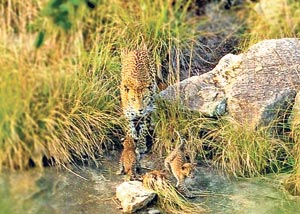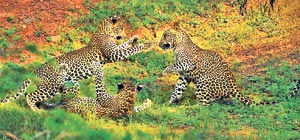Yala to us is one place that zeros stress. As a result we try to visit the park at least once a month. Wednesday, September 22, was another day with great expectations. We left Colombo at 4 a.m having booked the old Buththuwa bungalow overlooking the south east coast of the Indian Ocean. This bungalow is located close to the centre point of the main road that runs about 16 km, thereby giving one the option of deciding which side of the park one would like to visit.
We had with us a few friends, all great wild life enthusiasts. Hasitha Sanjay and Prabash Karunathilaka both having previous experience as rangers at the Yala National Park joined us together with the experienced ranger W.A. Wasantha and sought after driver Sumudu Sameera.
 |
| The proud mother with the 'Patanangala cubs' |
At the park we met Director General of the Department of Wildlife Conservation Ananda Wijesooriya who was on his routine inspection to monitor the development and progress of the Ruhunu National Park and he accepted our invitation to travel with us.
When we stopped at Koma Wewa bund, the DG spotted a tusker at the extreme end of the lake hurrying towards our jeep. This was Thilak, the largest tusker frequently seen in block one of Yala and he was in musth, during which time all male elephants are unpredictable and sometimes extremely aggressive. The tusker proceeded on the road and when we tried to photograph him from the side, turned towards us and laid his massive tusks on the buffer of our jeep, slightly damaging it.
September 22 being Poya, it was not one of the best days for leopard sightings. On Day two as well, leopard sightings were hard to come by - by evening we had only spotted two leopards at a distance and a sloth bear.
It was the last day of our stay. We had left early hoping for a leopard sighting. Driving along the Rukwila road, we heard a group of gray langurs making alarm calls. Then we spotted a leopard at the far end of the rock cliff. We drove parallel to the movement of this leopard and positioned ourselves where we believed the leopard would reappear. As expected the leopard arrived at the clearing, and to our surprise and delight, we spotted three new cubs, seen for the first time in Yala. We named them the Patanangala cubs.
We believe their age to be between 4-6 weeks. The cubs suckled from their mother and that was the first time we experienced such an awesome sight. Ironically this mother leopard is known to have reared two sets of cubs prior to this litter. The cubs of the second litter were spotted for the first time by our friend Chithral Jayatilake in the company of ranger Prabash who happened to be with us when we saw this litter. We photographed them for well over half an hour and were surprised by the presence of another adult leopard being in the company of this family.
This behavioural pattern totally defies all documented and published leopard behaviour in the world. Supposedly leopards are solitary animals and meet with other leopards only during the mating season. With years of experience of studying leopards at Yala, we have learnt that family groups including parents thrive well in the park. Two cubs aged about 14 months commonly referred to as the “Gonagala cubs” were seen sharing a meal with their parents.
 |
| Nearing their first birthday: The older Mahasilawa cubs |
This was recorded on Monday, September 20 by an international TV crew who are preparing a documentary of leopards and their behaviour patterns at Yala.
At present there are over 11 identified cubs regularly spotted at Yala. Pattiya wala, Mahasilawa has one large male, three cubs approximately 10 months old together with their mother.
Another different behavioural pattern observed in Yala is the sharing of territory by more than one resident leopard. In the not so distant past there were three resident males on the Gonalaheba Medapara within a distance of 2-3 km. To our surprise we spotted a leopard mating where the male was not one of the identified resident males that frequently roams on this stretch of road. The published norm is that leopards tend to not overlap territories unless there is a female in estrus and the possibility of mating is on the cards.
However a new observation point is being erected at Patanangala close to the spot where the three new cubs were spotted and this could be a hazard to these cubs growing to adulthood. With local and foreign visitors flocking to the park, identified as the world’s best location to watch and study leopard, we should focus on protecting these magnificent animals. |



